
Canyon Lake UMC walks with Native American families
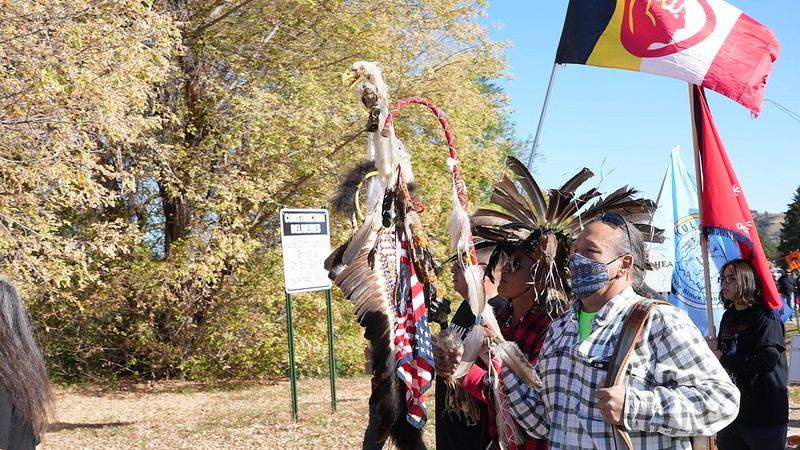
Participants gathered in Sioux Park on October 11, 2021, for the fourth annual Remembering the Children Walk. Photos by Nathaniel Wilson.
"It is hard to know the past and that we have been part of history that has caused pain, loss, and harm to people, "says Rev. DeAnn Eidem, lead pastor at Canyon Lake United Methodist Church. "This past year, our congregation has walked through a difficult, arduous process. We spent a lot of time praying and in conversation with people across our community. We are going to allow an easement for a road across our church property so that people can visit the Remembering the Children Memorial."
Pastor DeAnn, the leadership team, and members of Canyon Lake United Methodist Church (CLUMC) in Rapid City, South Dakota, have been learning, discerning, and praying about how to help honor the children who died decades ago while attending the Rapid City Indian School (RCIS). CLUMC learned this past year that the land adjacent to the church marks the graves of 50 children who lost their lives at RCIS.
Children like Tommy Afraid of Thunder. The Rapid City Daily Journal reported on June 13, 1906:
"At the age of 9-years, Tommy Afraid of Thunder died of tuberculosis of the brain at the Rapid City Indian School, on June 9, 1906. When it became clear that the little fellow would not live, the superintendent telegraphed Tommy's father, receiving no answer. He telegraphed agent Brennen, from who he also received no reply. A student was dispatched in haste across the reservation and met with better success, returning with the family of the boy. They were too late to find him alive. The deceased had only been sick for one week. Monday afternoon, Reverend S. G. Butcher conducted the simple service in the Indian School chapel, all the students being present. When the lad's friends started with the remains to the cemetery, all the students started to the cemetery, with the boys filing in one line string and the girls in another. The last words were said as twilight descended, and the Indian School's people sang very effectively."
History of Rapid City Indian School

Children walk on the campus of the Rapid City Indian School. Historical photo courtesy of Heather Dawn Thompson.
In the late 19th and early 20th centuries, Native American children were plucked from their families and forced to attend the Rapid City Indian Boarding School. By official government policy, they were stripped of their roots. Braids were shorn and their language forbidden. The personal and cultural disruptions reverberated throughout the students' and their descendents' lifetimes.
The federal government created a series of boarding schools to assimilate Native American children from the 1800s to-1960s. Several of these schools were in South Dakota, including the Rapid City Indian Boarding School (1898-1933). After serving as the Indian Boarding School, the facility became a segregated Indian tuberculosis clinic from the 1930s-1960s, called the "Sioux Sanatorium."
As with most Indian boarding schools, the mortality rate was very high, and the government did not keep records of the deaths of the children or where they were buried.
However, from oral histories and from years of independent research, including in the federal archived school records, it is known that at least 50 children and infants passed away, although the number is likely significantly higher.
Some children died at the RCIS, some traveling to or from the Boarding School, and others died trying to escape from the RCIS.
Heather Dawn Thompson, an attorney who researched the topic, and other volunteers with the boarding school memorial committee have identified 50 children, including eight whose names are unknown. Those children who died at the school ranged in age from infants to 19 years, and died of causes ranging from disease to malnutrition.
Through oral histories from descendants and community elders, inspections by Tribal Historic Preservation Officers (THPOs), and guidance from spiritual leaders, the unmarked graves of some of the children have been discovered.
Remembering the Children Memorial Walk
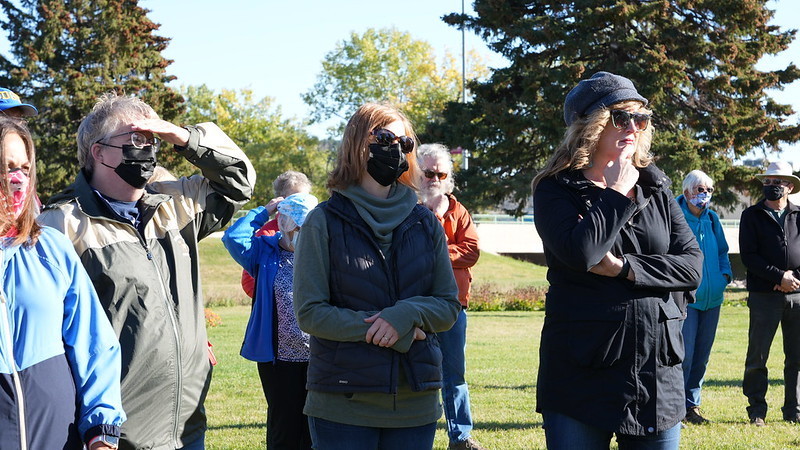
Members of Canyon Lake UMC (left to right) Kathy Torgerson, Rev. DeAnn Eidem, and Deb Kjerstad listen at Sioux Park.
Many schools and businesses were closed in honor of Native Americans' Day in South Dakota. In Rapid City, members of Canyon Lake United Methodist Church walked in remembrance of the children who died at the Indian Boarding School.
"It has been an honor to walk with you today. I walked with you for the first time last year. Our church has learned a lot in the last year about the history of this land," said Eidem, who joined others on the one-mile walk and spoke on the grounds adjacent to the church, where a memorial will be built.
The walk, in its fourth year, is hosted by Remembering the Children, a non-profit organization that researches and provides information related to the Rapid City Indian Boarding School, Sioux San, and the lands in west Rapid City.
The walk started at Sioux Park with prayer, song, and reading of the names. Each of the 50 children was remembered with a sign carried by a child or family member of the deceased. Then, participants traveled from the park to the Oyate Health Center, formerly known as Sioux San Hospital.
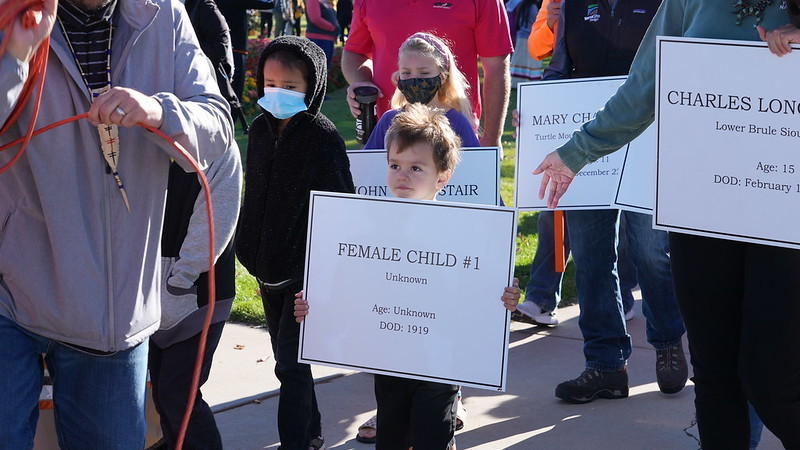
Adults and children carried memorial signs to honor children who died at or near the Rapid City Indian Boarding School.
Steve Allender, mayor of Rapid City, read a proclamation to declare October 11, as the Day of Grandmothers. "WHEREAS, while we are unable to change the past, we are able to face the difficult truths head-on through honest dialogue and collaboration in an effort to forge a better tomorrow for all children in this community. NOW, THEREFORE, I, Steve Allender, Mayor of Rapid City, do hereby proclaim Monday, October 11, 2021, as The Day of the Grandmothers—Unci Tha-anpetu."
Karen Mortimer, who serves as an ambassador for Mniluzahan Okolakiciyapi, an organization building bridges in Rapid City, shared a word of affirmation for the Remembering the Children work and the memorial walk. "The boarding schools were designed to destroy Indian tribes by erasing their language, culture, and traditions, as well as tearing families apart and traumatizing the children. These are difficult conversations. Conversations that will bring our communities together, offering a path toward healing. In this fourth year of the memorial walk, together we remember the children and the families that were forever affected by the government and the Rapid City community," said Mortimer.
More than 200 participants walked to the Sioux San campus and the site adjacent to the Canyon Lake United Methodist Church, where a memorial will be built.
Canyon Lake grants access to land
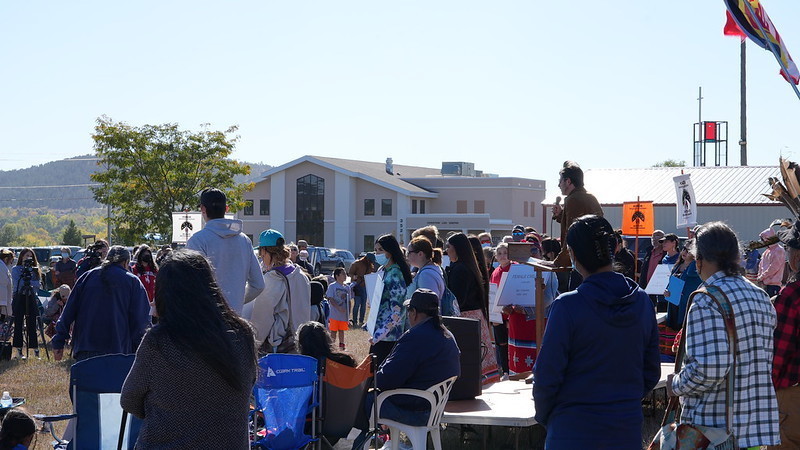
Canyon Lake served as the host for the memorial event, which included a meal.
"We're going to build a beautiful memorial for our children," Lafawn Janis told people gathered in front of a hill near the Sioux San campus and adjoined to Canyon Lake United Methodist Church. Janis, a member of the memorial committee, served as the MC for the activities for the memorial walk.
The memorial, called Remembering the Children, will give people a space to honor the children year-round, not just during the annual walks. It will be located on flat land and a hillside just west of Canyon Lake United Methodist Church. TerraSite Design, a Rapid City-based company, has created designs for the memorial, expected to cost nearly $2 million.
The memorial is designed to approach from the east on a boulevard and an allée of trees, or windbreak of trees. The boulevard will lead to a circle or a roundabout. In the middle of the circle or the roundabout will be the sculpture created by Dale Lamphere. There will be parking lots on each side of the boulevard. Behind the sculpture will be a color wheel plaza honoring the four directions.
"The circle is an important part of Native American culture along with entering from the east, especially toward a structure. This is represented in the memorial by the boulevard entering from the east, the allée, the roundabout, and the sculpture," says Eirik Heikes, the designer from TerraSite.
Currently, solar lights shine each evening, representing the 50 children known to have lost their lives at the Rapid City Boarding School. The memorial will feature a series of paths that will have a boulder or rock with the name of each child inscribed on the rock. In addition, a scaffold and lights will be installed on the ridge of the hill.
Efforts are also underway with the city to build a Native American Community Center. Land issues were fostered when the U.S. government gave away and sold the former boarding school land to governmental agencies, the City of Rapid City, and non-profits such as churches. The land was also supposed to be made available to “needy Indians,” but although requests were made, no land was ever given to those making such a request. Canyon Lake UMC bought the property where the church now stands and acreage around the church for $7,000.
The land to the north of the church parking lot will provide access to the memorial. "For us who have watched this process, for a long time, we are affirmed. At the vote of the congregation (to allow access) we witnessed overwhelming support," said Donna Fischer, a member of Canyon Lake UMC. "We have the space. We are ready and willing to grant them access."
In May 1948, Congress passed a bill authorizing the distribution of nearly 1,200 acres of the Rapid City Indian School lands (RCIS lands), including selling some of the acreages to churches for "religious purposes." In 1956, Canyon Lake United Methodist Church bought 9.45 acres as part of the authorization.
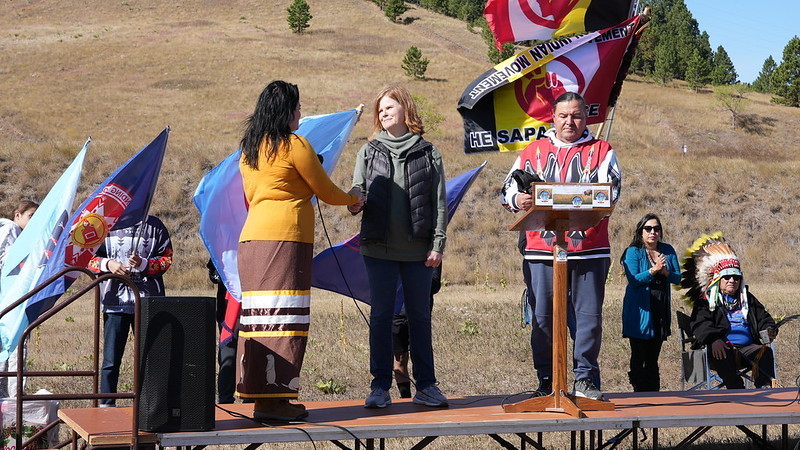
Heather Dawn Thompson, left, shakes hands with Rev. DeAnn Eidem, bridging the past.
Today, Canyon Lake UMC is housed on the acres that once housed RCIS. With the assistance of Heather Dawn Thompson, attorney and a researcher with Remembering Our Children, Rev. Bob Ruedebusch, Southwest District Superintendent for the Dakotas Conference, the CLUMC Leadership Team and the congregation voted to provide the necessary access to the land to the Remembering the Children Memorial.
"Some of the things have been very hard to hear. It has been hard to hear that the process by which this land was made available was not fair or just. It was hard to hear about the pain that happened at the boarding school. I want to tell you that our hearts are with you. We are proud and honored to help provide access to the memorial. As I stand here and look around at the beauty of the people here today, I want to thank you for letting us work together with you. I want to tell you that you are welcome here on this land and in these buildings. It is an honor to be here," said Rev. DeAnn Eidem.
Thompson responded with gratefulness. "We are standing here today because you opened your hearts and your land to us."
Helpful Links:
Remembering the Children website
Video presentation, “An Inconvenient Truth"
Article in Indian Country Today
Ted Talk by Heather Dawn Thompson, Director of the Office of Tribal Relations (reports to the United States Secretary of Agriculture)